Ertach Kernow - Brunel opens Saltash Railway to Cornwall
Brunel in opening the railway to Cornwall through the construction of the Royal Albert Bridge was a major achievement.
The River Tamar rises as a small spring on Woolley Moor in Morwenstow, Cornwall’s most northerly parish. Just short of 4 miles from the north Cornwall coast it runs for 61 miles to the Hamoaze with a number of rivers and streams including the Inney, Ottery, Kensey and Lynher joining it from the Cornwall side of the border. The Tamar is historically a Cornish river, King Athelstan of Wessex and England setting the border for Cornwall on the east side of the Tamar in 936. Over the past thousand years since the Norman conquest there have been some adjustments to parishes back and forth between Cornwall and Devon.
For millennia those coming to Cornwall had to cross the River Tamar by boat or via the north coast where the river narrows or begins. By medieval times, a number of bridges were constructed down as far as New Bridge at Gunnislake in 1520. Lower down than this travellers would have to take the ferries at Saltash, Torpoint or Cremyll.
The ferry at Saltash was established during the 12th century and owned by the Vautort (Valletort) family, Baron Trematon, until 1270 when sold. The burgesses of Saltash were granted a lease in 1385 and ran it until 1733 when the ferry sank drowning 20 people. Later ferries would be established running until the opening of the Tamar Road Bridge. Below this a ferry from Torpoint to Plymouth Docks was authorised by an Act of Parliament in 1790 and ran from 1791. The final crossing at Cremyll was an ancient ferry route believed to date back to before the 11th century and was often just a rowing boat.
During the period to the mid-19th century Cornwall had a number of mineral tramway’s and railway’s operating. These were owned by various companies run by entrepreneurs, originally as a means of transporting their tin, copper, iron and other mineral oars to the coast for export. The railway lines throughout England had grown dramatically following the great canal building period of the 18th century and by the mid-19th century passenger lines had reached Plymouth.
Cornwall’s ‘rail’ network evolved piecemeal over a number of years with the formation of various railway companies. To build a railway an act of parliament was required and in 1844 a meeting took place in Truro with the objective of constructing a railway line through Cornwall and linking with the South Devon Railway. Captain William Moorsom carried out a survey to pass a line through Torpoint, touching Liskeard near Bodmin and Lostwithiel through Par and St Austell to Truro. From there to Penryn and Falmouth, but no mention of how the Tamar was to be crossed by way of a bridge. The act was passed by the House of Commons in 1845, including a plan to ferry the train across the Tamar. The Bill was rejected by the House of Lords who wanted a more accurate survey and avoidance of a ferry across the Tamar at Torpoint.
Enter Isambard Kingdom Brunel, who was engaged to carry out a new survey and construct a railway bridge. Instead of having it crossing at Torpoint he planned to move it further up the river to Saltash. His first plan for an arched bridge was turned down as it was only 85 feet above the waterline and the Admiralty had stipulated that it should be at least 100 feet and not more than four spans.
Meanwhile the Cornwall Railway started construction of the line in Cornwall, dropping the Falmouth line at this stage and linking into the West Cornwall Railway running from Truro to Penzance. To cross the many valleys and keep costs low Brunel had designed a number of options for timber viaducts that would rest on stone pillars and there are wonderful images of these before they were eventually replaced completely in stone.
Due to lack of funding, there were many compromises to be made to get the project to completion along with many delays. However, by 1859 the line between Truro and St Germans had been completed. On the Devon side by 1858 the South Devon Railway had been extended as far as the Tamar bridge crossing. The uncompleted length in Cornwall was between Saltash and St Germans that included the viaduct superstructures.
It is impossible here to provide an adequate explanation as to the construction of what would be known as the Royal Albert Bridge, but needless to say it was once again a work of genius by Brunel, the Victorian’s age most versatile engineer. The building of the central pier had been a huge challenge, but by July 1858 the Cornwall span had been lifted in place and by the end of March 1859 the Devon side span completed. A trial train run was made between Plymouth and Truro on 12th April 1859.
On Monday 2nd May 1959 Prince Albert to whom the bridge is dedicated came to open the ‘Royal Albert Bridge’, he had given his permission to Brunel as early as 1852 to allow his name to be used for this purpose. This was an immensely important day for Cornwall and especially Saltash with a vast array of dignitaries present from both Cornwall and Devon.
The Mayor of Saltash, Mr J H Cook in his address noted the engineering skill, the uniting of Cornwall and Devon and emphasising the borough of Saltash as the main entrance. The train had slowly crossed the bridge and then alighting at Saltash Station the Prince recrossed the bridge on foot closely examining the construction. The Prince left Plymouth later that day and on the following day the Cornwall Railway was formally opened throughout its entire length Saltash to Truro.
The new line was broad gauge and in time this would be converted to narrow gauge. With many new lines being built throughout Cornwall including conversions from mineral tramways there were continued issues regarding the mixed use of broad and narrow gauge rail lines. There were also financial pressures, and this led in time to the Great Western Railway being asked to run the lines from 1877. Completion of the Royal Albert Bridge would lead to huge expansion in Cornwall’s industry especially that of tourism. The small town of Newquay would become the largest Cornish resort, in time having the longest railway platform in Cornwall. As Saltash’s mayor noted, Saltash became the main gateway to Cornwall and even more so in time with the completion and formal opening of the Tamar Road Bridge in April 1962.
Sadly, the opening of this unique rail bridge the only one of its type, was not attended by the architect engineer who had conceived and organised its construction. Brunel was very ill and was in Rome recuperating and returned two days afterwards, crossing the bridge on a couch in an open carriage. He then returned to London to continue supervising construction of the Great Eastern, the world’s largest ship at that time. On 5th September 1859 Brunel died, leaving a fantastic legacy to future generations of railway lines, numerous bridges and tunnels and of course the SS Great Britain, the first propeller-driven, ocean-going, iron ship, which can be seen in Bristol.
In case anyone should forget who was instrumental in constructing the Royal Albert Bridge, making Saltash the gateway to Cornwall and benefiting the Cornish economy far into the future, lettering was installed at both ends of the bridge. These say I. K. Brunel Engineer 1859, perhaps why so many people know it as ‘The Brunel Bridge’.
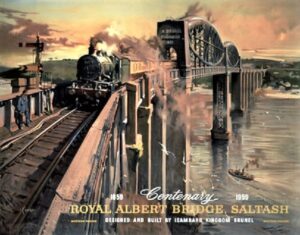
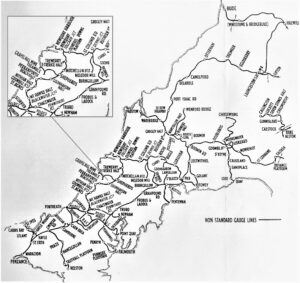
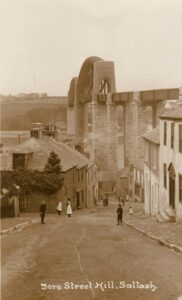
![Saltash under Royal Albert Bridge [1936] Saltash under Royal Albert Bridge [1936]](https://www.cornwallheritage.com/wp-content/uploads/2021/04/Saltash-under-Royal-Albert-Bridge-1936-208x300.jpg)
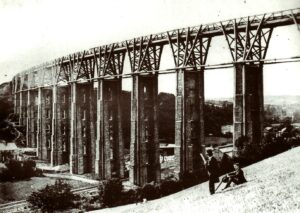
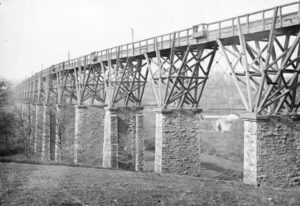
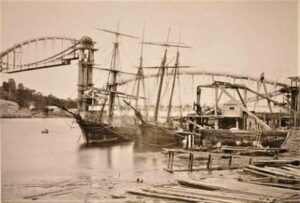
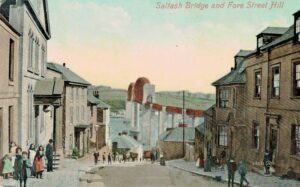
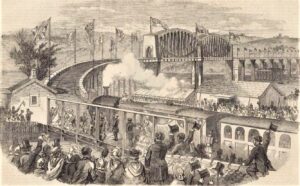
![1859 Opening of the Royal Albert Bridge [2] 1859 Opening of the Royal Albert Bridge](https://www.cornwallheritage.com/wp-content/uploads/2021/04/1859-Opening-of-the-Royal-Albert-Bridge-2-300x194.jpg)
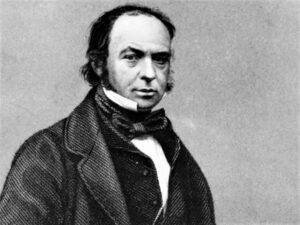
![I K Brunel Engineer [RAB] I K Brunel Engineer [RAB]](https://www.cornwallheritage.com/wp-content/uploads/2021/04/I-K-Brunel-Engineer-RAB-234x300.jpg)
![[42] Voice - Ertach Kernow-140421A - Brunel opens the gateway to Cornwall [S] Ertach Kernow - Brunel opens the gateway to Cornwall](https://www.cornwallheritage.com/wp-content/uploads/2021/04/42-Voice-Ertach-Kernow-140421A-Brunel-opens-the-gateway-to-Cornwall-S-235x300.jpg)
![[42] Voice - Ertach Kernow-140421B - Brunel opens the gateway to Cornwall [S] Ertach Kernow - Brunel opens the gateway to Cornwall](https://www.cornwallheritage.com/wp-content/uploads/2021/04/42-Voice-Ertach-Kernow-140421B-Brunel-opens-the-gateway-to-Cornwall-S-231x300.jpg)